LOL
This giant banner at Bad Axe Toolworks made me laugh out loud. You know Roubo is catching on when the yardstick for a tool is its ability to cut the dovetailed leg tenons for a Plate 11 workbench.
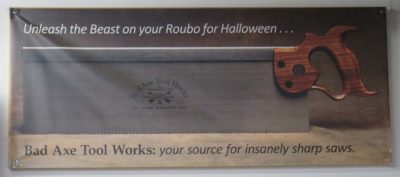

This giant banner at Bad Axe Toolworks made me laugh out loud. You know Roubo is catching on when the yardstick for a tool is its ability to cut the dovetailed leg tenons for a Plate 11 workbench.


My recent trek around Flyover Country included an intersection between my path to my home town in southern Minnesota (the tropical part) and LaCrosse, Wisconsin, home to Mark Harrell and his ambitious enterprise Bad Axe Tool Works. I’ve been collaborating with Mark for some time on the development of a frame saw/sash saw with the promise that he would put one in my hands.
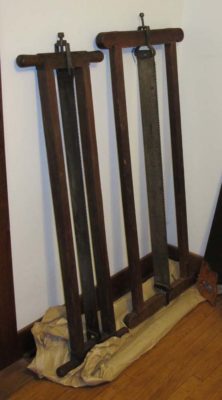
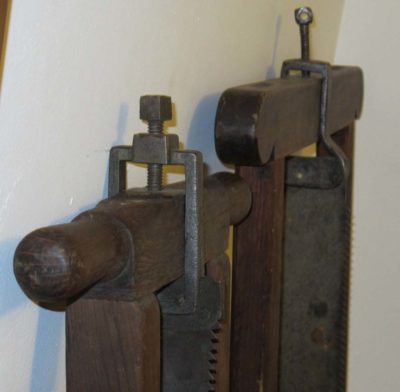
As the owner of two c. 1800 four-foot frame saws I was delighted to share the particulars about them with anyone who wanted to know. Their details are spectacular, from the hand forged hardware to the forged plates in near-perfect condition. (by that I mean there are no kinks or missing teeth, there was plenty of surface rust and the teeth needed touching up)
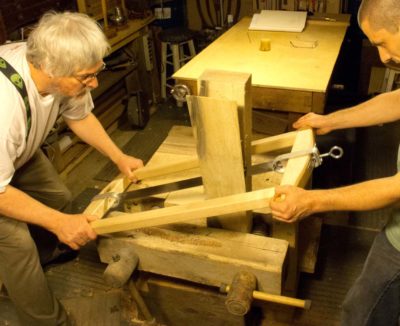
Like other saw makers, Mark contacted me some time ago and I took the time to talk with him at length about the vintage saws I have, in addition to the diminutive version I made for myself. Mark was particularly interested in a model halfway between my vintage big ones and my new smaller one, and we worked out the details over many emails and phone calls, an interchange I welcome from any tool maker who wants my two cents worth. To this point my only fee is that I get one of the tools in question if they ever go into production. I think Bad Axe might have had this model at Handworks 2017, but I was so busy I could never get to their station once they got set up, so this was my chance.
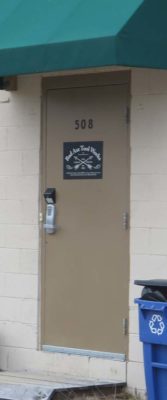
Accompanied by The Oldwolf, Derek Olsen, we arrived late-morning. And the saw geek-dom commenced. Behind this modest door and awning is a buzzing hive of saw making.

Mrs. Barn and I got a quick tour of the facility, getting the opportunity to meet and greet each of the the sawmaking elves there.
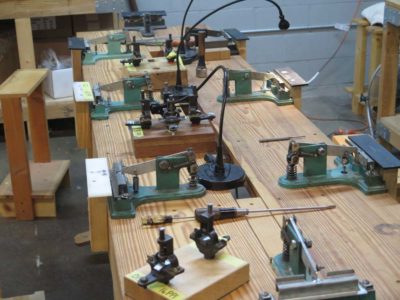
I was especially impressed with the classroom they have set up there for saw making and sharpening workshops. Mark definitely has the leads for mondo saw sharpening vises and setters.

Then we got down to the real fun as Mark brought out several models of saws for me to play with. I already own two Bad Axe saws, including a custom made dovetail saw I commissioned and that has now become ensconced in their product line. Under Mark’s watchful eye the playing commenced, and it was glorious!

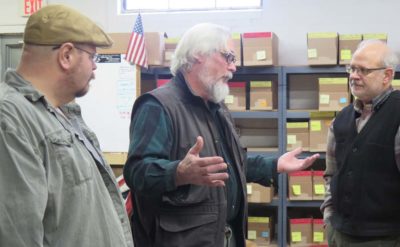
Our exploration of the topic continued almost non-stop and we were torn between talking about saws, and sawing.
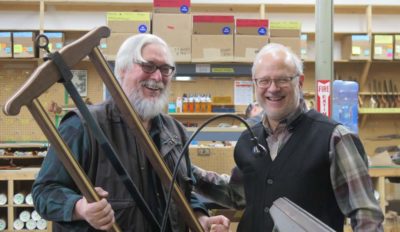
Then came the “official” purpose of the visit, taking delivery of my own Bad Axe frame saw based on Roubo, my old saws, and my new one, with a bit of Bad Axe special sauce tossed in for good measure.
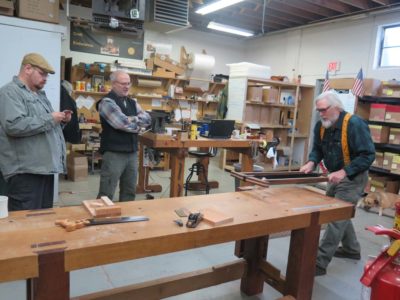
It performed perfectly right out of the box and will be integrated into my shop work as soon as it gets home.
More about the visit in the next post.
A recent trip to the Midwest for a variety of family gatherings provided a chance to drop in on Derek Olsen of Oldwolf Workshop fame. Derek’s is a fairly recent entrance into my orbit, but our friendship is fast and strong. He was first among the multitude of friends who volunteered to help with the 2015 HO Studley exhibit, and his account in The Bank of Don is brimming.

The stop for fellowship was a delightful one as you might expect.

Derek proudly showed his impressive library of furniture history books, his shrine to Studley, and his still-in-development shop in the garage next to where he and Mrs. Oldwolf moved in recent years.
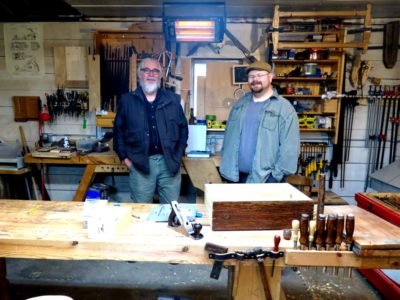
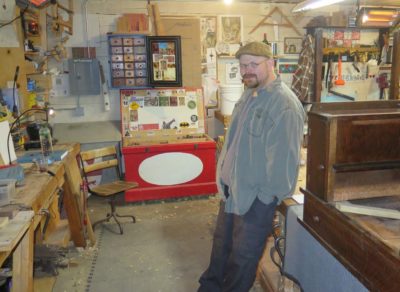
After our time there, we headed down the road (actually only a few blocks) to some time of saw geek-dom at Bad Axe.
But that’s for the next post.
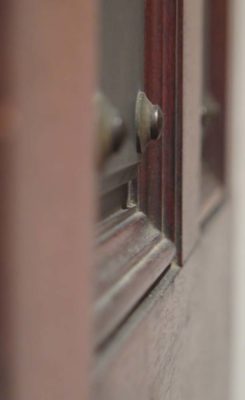
I blogged recently about visiting my friend, Mister Stewart, and his ensemble of the Henry Studley tool cabinet and workbench. One of the purposes of the visit was to get a better picture of the molding profile on the cabinet, but Mister Stewart did one better than that. During his fabrication of the new workbench base he replicate exactly the moldings from the tool cabinet and gave me one of the scraps from that enterprise. I finally got a chance to take a picture, and here it is.
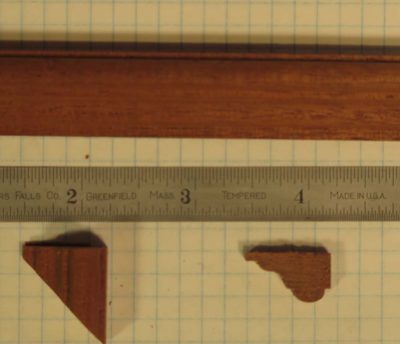
If you would like a better resolution picture of the cross-section, drop me a line here.
Here’s a list of the Barn workshops I’ve pencilled in for this year. I will blog in greater detail shortly.
Historic Finishing April 26-28, $375

Making A Petite Dovetail Saw June 8-10, $400
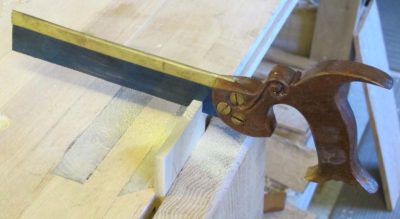
Boullework Marquetry July 13-15, $375

Knotwork Banding Inlay August 10-12, $375
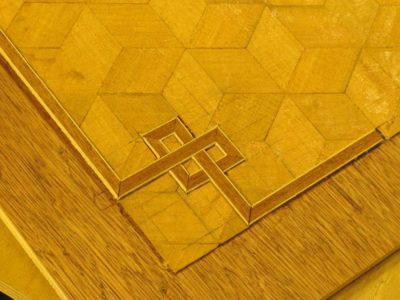
Build A Classic Workbench September 3-7, $950

Notwithstanding the fact that I believe we are living in The Golden Age Of Woodworking Tools, the precipitous decline and apparent imminent demise of Sears/Craftsman is a cautionary tale, although I remain uncertain of its ultimate meaning. As a devotee of Joseph Schumpeter’s “creative destruction” premise, I do not mourn Sears/Craftsman’s passing as much as I celebrate the role going to the Sears tool department played in my early life. The tool department was large, the shelves fully stocked with high quality products, and the sales folks knew what they had and how to use it. Really. That is probably incomprehensible to anyone going to Sears now, but it was true in 1970.
The trips there with my Dad were too numerous to recall, and were equal parts utilitarian errands and incalculable treasure hunts. Our bond of toolism and tinkering was foundational, continuing until the day he took his final breath and we parted with no unfinished business. In fact that bond remains as after his funeral my brothers and I divvied up his tools, some of which get used in my shop now.
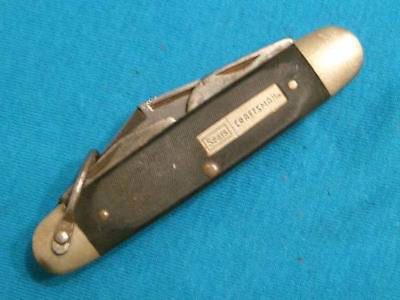
The first tool I ever bought with my own lawn-mowing money was this pocket knife, still in use 49 years after its purchase. (full disclosure — I could not lay my hands on mine at the moment, it is probably in a pair of pants or overalls that I have hanging on some hook in some closet. This is an identical one I saw on ebay.)
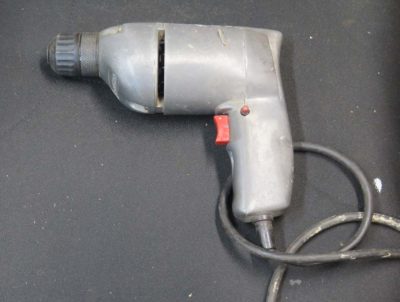
My first power tool was this 3/8″ Craftsman drill, still going strong after 47 years. It’s a low-speed, high torque unit that can just as easily spin you around if used carelessly. The only changes from the day I bought it are a new power cord and Jorgensen chuck.
I still have many other wrenches, sockets, and screwdrivers from the same store bought around the same time. None has ever given me a lick of trouble.
But recently my mondo Craftsman Shop Vac gave up the ghost, after only 44 years of faithful service. Or at least I inferred that it was dead based on the acrid smoke shooting out of the motor casing moments after it ceased operating with a snap, crackle, and pop. I did not even bother with an autopsy, merely cutting off the power cord and taking the canister lid to the dump (I never throw away a good power cord). I saved the rolling base, it still serves as a receptacle for scraps.
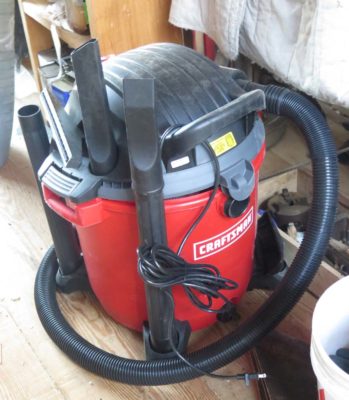
On the way home from the dump I stopped at our local farm coop and hardware store and bought a successor model. Given the current state of Craftsman products, I guess I will only get 30 years or so from it. I can only imagine how cranky I will be shopping for a new one at 92.
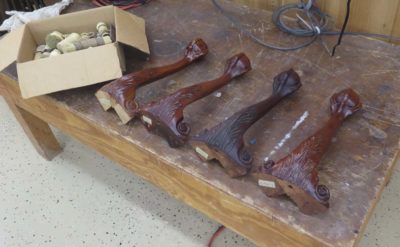
Right after the conclusion of the Parquetry workshop at the Marc Adams School of Woodworking I dove in again with three days of Historic Finishing (reminder to self — DO NOT do this again. The logistics of changing horses mid-week is a headache you can do without). This class had more than a dozen students, and the enthusiastic feedback had led Marc to ask me to develop an expanded week-long workshop on the same topic, which we will do in 2019.
I’ve pretty much got this workshop dialed in, as I do with Parquetry, so there is a fairly fixed syllabus here. The emphasis is on processes and work habits rather than having a “completed” project at the end, concentrating on shellac spirit varnishes and beeswax applications.

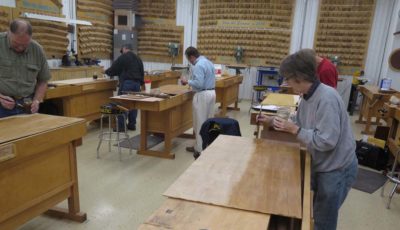
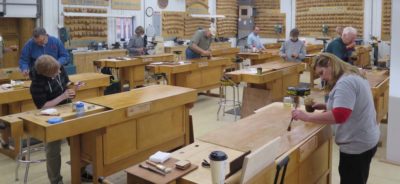
The starting point is this 24×48 panel building up multiple brushed applications of 1-1/2 pound cut shellac to about 18 layers over the first day and a half. Getting this to “done” allows us to explore the detailing and polishing of the surface.
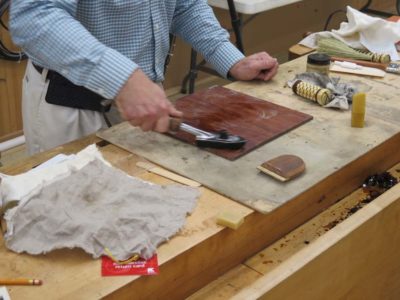


We used polissoirs for preparing surfaces and applying wax, and filled the grain with molten beeswax. Then we made and used polishing pads for applying spirit varnish.
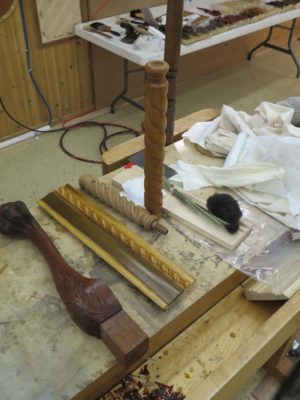
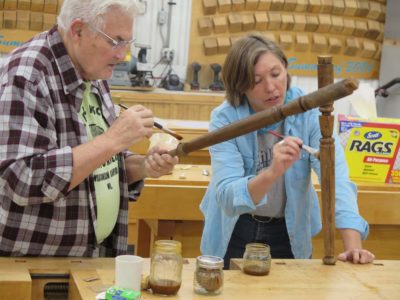
Each student got to address the problems of finishing undulating surfaces,
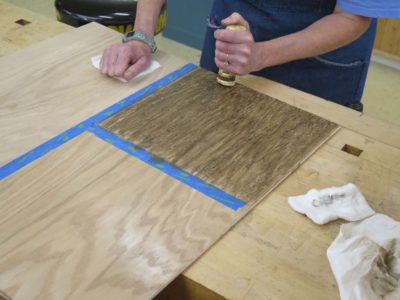
applying pigmented wax grain filler,
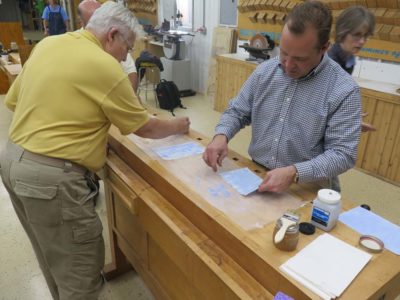
and even making historic sandpaper.
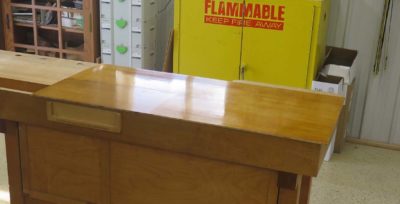
The giant panels were polished out with a variety of period-appropriate abrasives,

and one quadrant was glazed with asphaltum.
All in all, it was a great time of fellowship and learning. How could it not be, we were finishing!
I recently spent a week at the Marc Adams School of Woodworking, teaching two three-day courses. I believe this was an experiment on Marc’s part, road testing some new scheduling concepts such as a three-day workshop during the week as opposed to only on weekends.
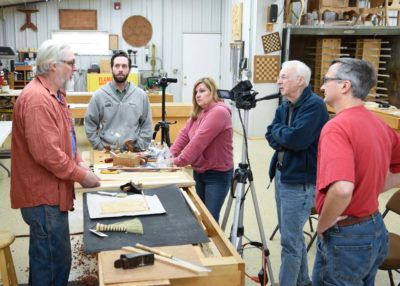
The Parquetry workshop had three enthusiastic attendees (plus a most excellent teaching assistant), a number the Marc told me precludes any repetition of the topic. This is an entirely fair conclusion on his part as he has a huge footprint to support. With several classrooms in simultaneous use I’m guessing he needs somewhere between 35-50 attendees every day for six months to make it work.
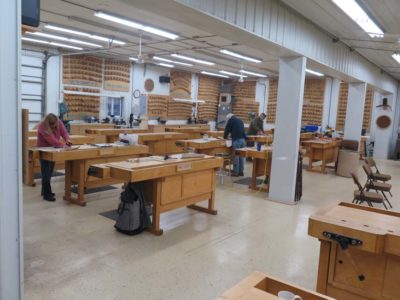
In fact our merry little band was in a huge, well equipped classroom with twenty (?) workbenches. The spaciousness was both unnerving and delightful as the students could spread their projects as widely as they wanted.
This workshop is somewhat unusual for me in that there was a finished project at the end, while I tend to prefer teaching a skill-set rather than a project.


But skills and processes were taught and practiced, including the making of sawing and planing jigs,
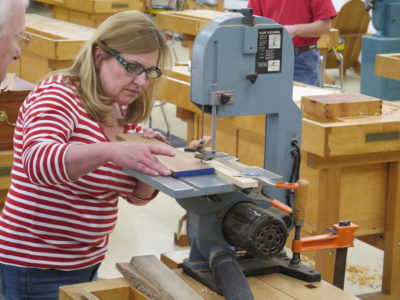
sawing veneer stock for making the patterns,

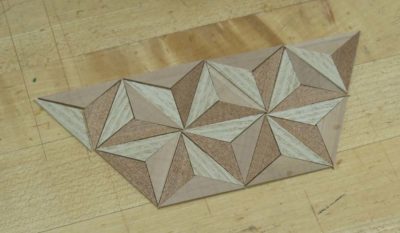
the assembly of the patterns,
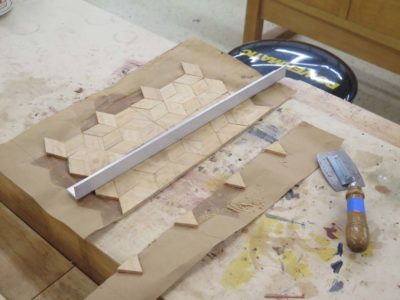
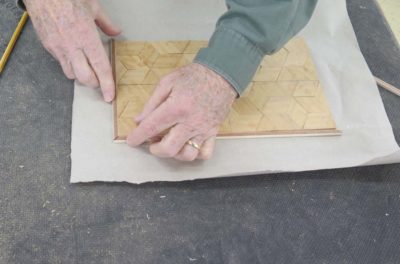
fabricating and integrating simple bandings,
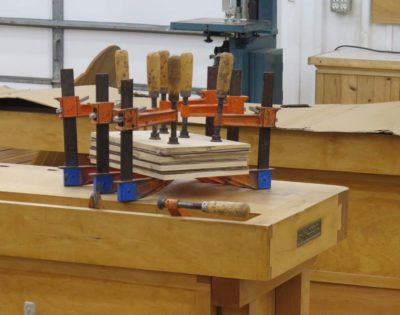
and gluing them down to a substrate.


In the end they were cleaned up with toothing planes, files, and scrapers making them ready for the finishing process.
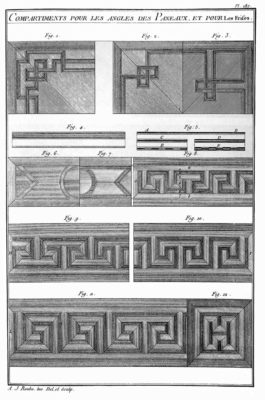
Though I will not be teaching this workshop again at MASW, I will not completely set the general topic aside. I am hoping to have a workshop on knot-work banding perimeters there in 2019.
Recent Comments